| Page last updated
1 January 2010 |
What's New with the MUSSELp?
The highlights of 2009.
10-21 December 2009. – The Mussels in Brussels: the MUSSELp Wrangles the Last of the Collections with Major African Holdings. DLG and KSC spent 10 days capturing the data in two Belgian collections with the able assistance of recent Bama graduate Jonah White. We were also lucky enough to be joined by our old friend Bert Van Bocxlaer of the University of Ghent.
Since 2002, DLG and KSC have been capturing specimen images of Gondwanan freshwater mussels species (this web site is an archive of those adventures). Through November 2009, we had digitized over 17,500 lots from 15 major research collections. For 10 days in December, we were able to acquire data on more than 2000 lots from two additional collections. |
|
|
The two Belgian collections were the Royal Belgian Institute of Natural Sciences in Brussels and the Royal Museum for Central Africa in Tervuren. By an oversight resulting from our naivety when we initiated this collaboration, neither of those collections had been included on our original REVSYS grant from NSF. Fortunately, we were able to correct this error with further funding, as part of a 2nd grant to study Congolese mussels. The vast majority of these new specimen records are from Africa.
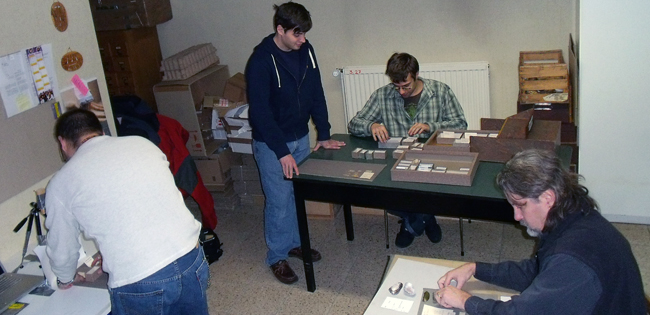
DLG, Jonah White, Bert Van Bocxlaer, and KSC working as a well-oiled machine at MRAC.
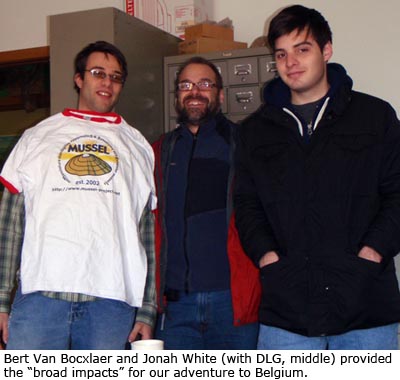 This particular museum trip was beset with various challenges, including but not limited to: uncooperative winter weather in both North America and Europe, the untimely demise of our 2nd digital-specimen-shooting camera, and the weak dollar. But things worked out in the end. For example, whereas KSC arrived a day late because of a blizzard in Illinois, we all got to stay in Brussels an extra day because of snow in Brussels. This particular museum trip was beset with various challenges, including but not limited to: uncooperative winter weather in both North America and Europe, the untimely demise of our 2nd digital-specimen-shooting camera, and the weak dollar. But things worked out in the end. For example, whereas KSC arrived a day late because of a blizzard in Illinois, we all got to stay in Brussels an extra day because of snow in Brussels.
Beyond the intellectual merits of sequestering more data into the MUSSELpdb (and there are many!), we also used this trip as an opportunity to expand the “broad impacts” of our research. During his last two terms as a University of Alabama undergraduate, Jonah White had been working in DLG’s lab to update specimen localities in the database. Jonah continued his contribution to freshwater mussel diversity research by providing another set of hands to get the specimens under the camera. Our expeditionary force was expanded to a foursome by Bert Van Bocxlaer, a graduate students. These sorts of student-professional collaborations demonstrate the educational component of the MUSSEL Project.
Our thanks to Jonah and Bert — as well as Thierry, Rose, Rudy, Didier, and Dirk who also contributed in various ways to our success in Belgium. Thanks also to the National Sciences Foundation for their support. |
 19 October 2009. — Graduate Student Research Opportunities. For Fall 2010, DLG is seeking two students interested in pursuing graduate research in his laboratory at the University of Alabama. Qualified students (M.S. or Ph.D.) are eligible for teaching/research assistantships through the Biology Department as well as external grants. 19 October 2009. — Graduate Student Research Opportunities. For Fall 2010, DLG is seeking two students interested in pursuing graduate research in his laboratory at the University of Alabama. Qualified students (M.S. or Ph.D.) are eligible for teaching/research assistantships through the Biology Department as well as external grants.
Topics for graduate student research projects are open to any that enhance the scope and impact of freshwater invertebrates research at the University of Alabama. For students interested in studying the family-level relationships of freshwater mussels (order Unionoida), up to two years of graduate research fellowship funding will be available from the NSF-funded Bivatol (Bivalve, Assembling the Tree of Life) Project.
More information is available on DLG's web site, http://bama.ua.edu/~dlgraf/grad_students.html. |
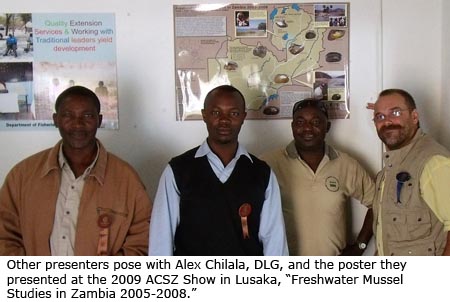 20 July-8 August 2009. -- DLG spreads the Good News about Zambian freshwater mussels and makes additional samples from the upper Congo Basin. DLG and Alex Chilala presented a poster at the 2009 ACSZ Show in Lusaka (co-authored with KSC) and sampled additional sites in the upper Congo Basin. The poster ("Freshwater Mussel Studies in Zambia 2005-2008") highlighted the results of the previous 4 years of work on Zambian unionoids, including both field and museum work. The research presented was funded by the National Science Foundation and conducted in collaboration with the Zambian Ministry of Agriculture & Cooperatives Department of Fisheries. 20 July-8 August 2009. -- DLG spreads the Good News about Zambian freshwater mussels and makes additional samples from the upper Congo Basin. DLG and Alex Chilala presented a poster at the 2009 ACSZ Show in Lusaka (co-authored with KSC) and sampled additional sites in the upper Congo Basin. The poster ("Freshwater Mussel Studies in Zambia 2005-2008") highlighted the results of the previous 4 years of work on Zambian unionoids, including both field and museum work. The research presented was funded by the National Science Foundation and conducted in collaboration with the Zambian Ministry of Agriculture & Cooperatives Department of Fisheries.
The major goal of the trip, however, was to sample Lake Mweru and other sites in that lake's watershed. In 2007, sampling had recovered specimens of all four species known to occur in Lake Mweru but had only found Prisodontopsis live. Our 2008 expedition to the Congo Basin had been successful but, due to time constraints, had not made it as far north as Mweru. During this last trip, we were able to hire a boat and sample the leeward side of Kamanda Island, and there we found live Mweruella mweruensis and Mutela hargeri as well! Additional sites were sampled as well, and more information can be found by clicking here.
In addition to Mr. Chilala and DLG, the expedition included William Bone as a field assistant and Phil Harris of the University of Alabama. Dr. Harris hopes to continue sampling in the upper Congo, and we had a very productive meeting with the Director of the Fisheries Department where we discussed the expansion of our successful collaboration.

Dan Graf
|

Alex Chilala
|

Phil Harris
|

Bill Bone
|
|
 June-July 2009. -- KSC et al. takes Illinois freshwater mussel diversity research to the next level. KSC is the CO-PI (with Ann Holtrop at the Illinois Department of Natural Resources) on a new project to investigate mussel communities in Illinois streams. This project will collect baseline mussel data in conjunction with existing basin surveys for fishes on wadeable streams in Illinois. The project is part of the Illinois' Wildlife Action Plan, and the data collected will support revisions of current mussel community indices, assist water quality initiatives, and guide restoration initiatives in Illinois waters. June-July 2009. -- KSC et al. takes Illinois freshwater mussel diversity research to the next level. KSC is the CO-PI (with Ann Holtrop at the Illinois Department of Natural Resources) on a new project to investigate mussel communities in Illinois streams. This project will collect baseline mussel data in conjunction with existing basin surveys for fishes on wadeable streams in Illinois. The project is part of the Illinois' Wildlife Action Plan, and the data collected will support revisions of current mussel community indices, assist water quality initiatives, and guide restoration initiatives in Illinois waters.
Three new full-time staff members were recently hired (Sarah Bales and Alison Price at INHS in Champaign and Diane Shasteen at the INDR in Springfield, Illinois), and together with six summer field assistants initiated sampling in June 2009. We have many objectives for this project but the overall scope of the project is to sample approximately 120–150 sites per year and collect baseline mussel data in 33 basins by 2011.
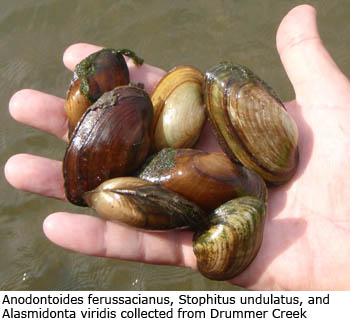 In addition to collecting mussels and associated mollusks, we hope to investigate the overall efficiency of our current sampling protocols. This part of the project will be conducted by Jian Huang (M.S. student at the University of Illinois) under the direction of Dr. Yong Cao at INHS. Jian and Dr. Cao are currently compiling landscape-level and site-specific data to guide site selection for the project. Dr. Cao has published extensively on sampling standardization, species detectabilities, and estimates of species richness among fish and invertebrate assemblages. In addition to collecting mussels and associated mollusks, we hope to investigate the overall efficiency of our current sampling protocols. This part of the project will be conducted by Jian Huang (M.S. student at the University of Illinois) under the direction of Dr. Yong Cao at INHS. Jian and Dr. Cao are currently compiling landscape-level and site-specific data to guide site selection for the project. Dr. Cao has published extensively on sampling standardization, species detectabilities, and estimates of species richness among fish and invertebrate assemblages.
|
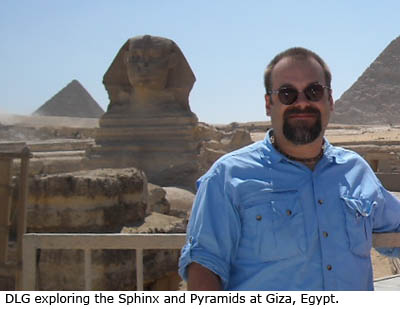 2-9 May 2009. -- MUSSELpdb used to inform freshwater conservation priorities for Africa at Cairo IUCN workshop. DLG traveled to Cairo, Egypt to take part in IUCN Red List Assessments for African freshwater fishes, mollusks, plants, and dragonflies. This involved being sequestered in a hotel meeting room for most of each day to go species-by-species through the African mollusk assemblage and discuss among the mollusk specialist group what might be known (or unknown) about the biology and distribution of each little snail or bivalve. 2-9 May 2009. -- MUSSELpdb used to inform freshwater conservation priorities for Africa at Cairo IUCN workshop. DLG traveled to Cairo, Egypt to take part in IUCN Red List Assessments for African freshwater fishes, mollusks, plants, and dragonflies. This involved being sequestered in a hotel meeting room for most of each day to go species-by-species through the African mollusk assemblage and discuss among the mollusk specialist group what might be known (or unknown) about the biology and distribution of each little snail or bivalve.
The workshop pulled together a Who's Who of authorities on African freshwater biodiversity, and the whole thing went very smoothly thanks to our hosts at the IUCN Freshwater Biodiversity Unit.
The trip to Cairo also provided an opportunity to visit with the Al Mahar group. |
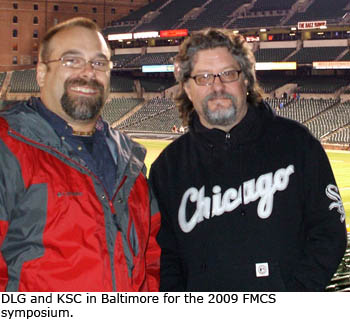 19-23 April 2009. -- DLG and KSC present at the biennial FMCS symposium in Baltimore. Two years of MUSSELp-mania has rolled by again, and it was time for another Freshwater Mollusk Conservation Society meeting. This year the group met in Baltimore, MD on the Harbor for three days of talks and networking. 19-23 April 2009. -- DLG and KSC present at the biennial FMCS symposium in Baltimore. Two years of MUSSELp-mania has rolled by again, and it was time for another Freshwater Mollusk Conservation Society meeting. This year the group met in Baltimore, MD on the Harbor for three days of talks and networking.
The theme of this year's symposium was internationalism, and we contributed by presenting a plug for our recent paper on the subject of global freshwater mussel species diversity. The title of our talk was "There are about 300 species of freshwater mussels in North America. Is that a lot?", and the objective was to put the Nearctic assemblage into a bit of a global context. We provided updated data beyond what was printed in the published abstract (we had submitted that months before). We increased the number of South American taxa in our tally based upon KSC's ongoing work. And, the publication of our recent faunistic revision of the species reported from Madagascar and the Mascarene Islands took away a few species, for a net gain of about a dozen: 854 freshwater mussel species on Earth, rather than the 840 we published in 2007.
Click here to find out more about our presentation at the symposium, and click here to find out about our new revision of the Malagasy-Mascarene freshwater mussel assemblage. The latter includes the description of a new genus, Germainaia. |
|